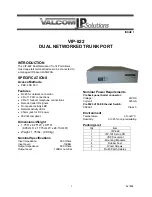Web Interface Settings Glossary
108
Maximum Window Size K
Defines the Maximum Window Size, which is the number of frames that are to be sent
before the Eicon 1550/1551 waits for an acknowledgment from the remote device. In
certain situations, you may wish to define a large window size (with satellite networks
that have significant transmission delays, for example). The maximum window size can
never be exceeded, and it must match on both sides of the link.
Range: 1-7, or 1-127 if Extended Sequence Mode is enabled. Default: 7
Extended Sequence Mode is defined with the ‘Sequence’ parameter.
Link Setup
Defines how the HDLC Link setup procedure is handled. Applies only if a DTE port has
been configured.
• Active: The Eicon 1550/1551 will initiate the setup procedure. This option is generally
used with DTE addressing.
• Passive: The Eicon 1550/1551 will wait for the remote device to initiate the setup
procedure.
Default: Active
Sequence
In 1984, the CCITT added an Extended Sequence definition to the X.25 specification.
These features are useful for networks with long transmission delays, such as satellite
networks. Consult your network provider to see if you can make use of Extended
Sequence features. This parameter increases the range of values available for
Maximum Window Size.
• Normal: Sets the range for Maximum Window Size to 1-7. Use for most networks.
• Extended: Sets the range for Maximum Window Size to 1-127. Use for networks
supporting the Extended Sequence definition.
Default: Normal.
X32 Dialout
Enables/disables X.32 dialout. Default: Disabled.
Maximum Retry Count (N2)
Defines the Maximum Retry Count, which is the limit to the number of retries made
when a particular frame meets with repeated negative acknowledgments from the
remote device.
Range: 1-99. Default: 10.
Reject RR/RNR/REJ Frames
Enables/disables rejection of RR/RNR/REJ frames that have their poll bit set to 0.
Certain networks use the HDLC poll bit in a non-standard manner and require special
handling of the three frame types:
• RR (receiver ready) frames
• RNR (receiver not ready) frames
• REJ (reject) frames
Normally, when any of these three frames are received as commands with the poll bit set
to 0, they are rejected. Non-standard networks may not want these frames to be rejected.

















